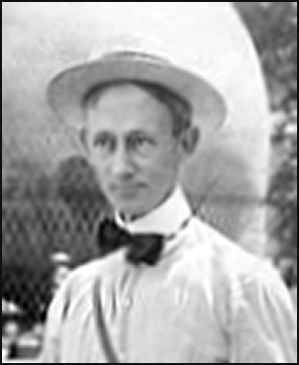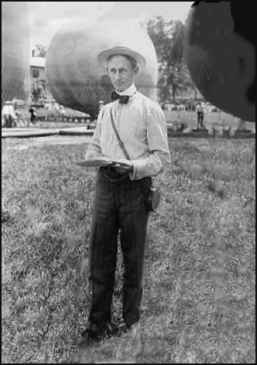
1863-1927 |
 |
Library of Congress Collection, 12-1-06 |
|
Aviation Industry in Connecticut Hamilton of New Britain was the first. Chucking his dirigible, he learned to fly airplanes under the great Glenn H. Curtiss in late 1909 and within six months his daring flight exhibitions throughout the United States made him perhaps the best known America flyer at that time. When on July 2, 1910 Hamilton returned to his hometown, New Britain, to show the home folks what flying was like, he was already a popular idol. An estimated 50,000 people gathered at New Britain to watch him make the first public flight in the State. Soon New Britain and Bridgeport became the centers of aviation in the State... |
 |
Library of Congress Collection, 12-1-06 |
|
Meanwhile, at Bridgeport, much flying and experimentation took place but little manufacturing. The
leading lights were Christopher Lake, (son of Simon Lake of submarine fame),
A. Holland Forbes and Stanley Yale Beach. Wealthy balloonist Forbes organized the Aero Club of Connecticut and wrote the
basic draft for the first aeronautical law in the United States, passed by the Connecticut Legislature and signed into law by Governor
Simeon Baldwin on June 8, 1911, and was appointed Connecticut’s first Commissioner of Aeronautics. This was a feeble first step to
regulate public safety in a form of transportation which hardly existed. Lake experimented with jet propulsion in aircraft from 1909 to
1918. Beach sponsored Gustave Whitehead and played around with several projects, none of which
produced anything of real technical value. Harvey Lippincott in 1977 at the Meeting of the Association for the Study of Connecticut History. It is made available through the courtesy of THE NEW ENGLAND AIR MUSEUM I highly recommed that you visit this site. It is a treasure of articles and photos for fans of aviation. |
|
A. HOLLAND FORBES, EDITOR, DIES SUDDENLY Publisher of The Architect Suc- cumbs After an Operation--- Won Fame as a Balloonist About twenty years ago Mr. Forbes was internationally known as a balloonist. In October, 1909, accompanied by Max C. Fleischmann of Cincinnati, he won the Lahm Cup offered by the Aero Club of America for the longest flight made in the United States during the year. The balloon, The New York, covered 731 miles in 19 1/4 hours. In the same balloon Mr. Forbes had previously won the duration contest at Indianapolis. On at least two occasions Mr Forbes had a narrow escape. At the Berlin races in October, 1908, while aloft in The Conqueror, with Augustus Post, the gas bag caught fire and the balloon fell rapidly. Fortunately, the torn bag formed a sort of parachute that enabled the men to escape with bad shake-ups. In May, 1910, Mr. Forbes and C. Carrington Yates landed on a farm in Green County, Ky., almost unconscious from the effects of high altitude and the hard landing. Their balloon, The Viking, was said to be the largest in the world at the time. It had a gas capacity of 85,000 cubic feet. Mr. Forbes was formerly Vice President of the Aero Club of America and he continued an active member of the club, retaining to the last his keen interest in all forms of aviation. He also belonged to the New York Yach Club and the National Golf Links. Kindly supplied by Alexander P. Scott If you have any information on this Early Flier, please contact me. E-mail to Ralph Cooper 

|